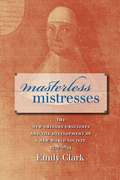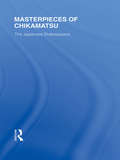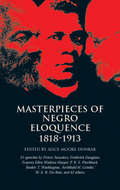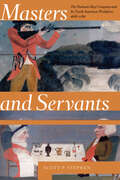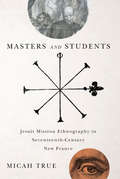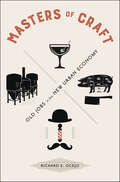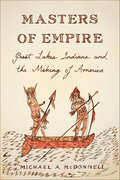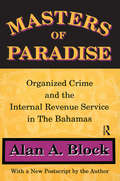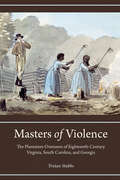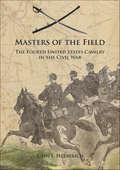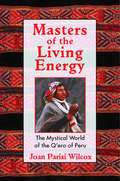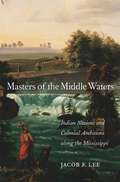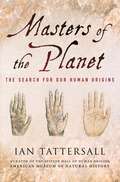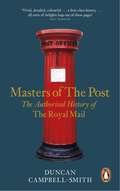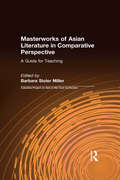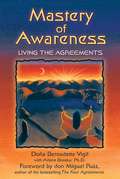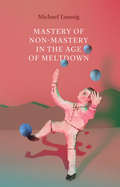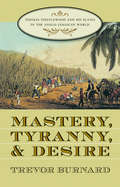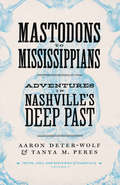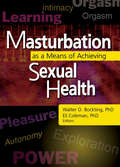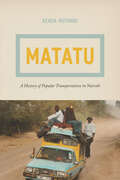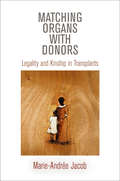- Table View
- List View
Masterless Mistresses
by Emily ClarkDuring French colonial rule in Louisiana, nuns from the French Company of Saint Ursula came to New Orleans, where they educated women and girls of European, Indian, and African descent, enslaved and free, in literacy, numeracy, and the Catholic faith. Although religious women had gained acceptance and authority in seventeenth-century France, the New World was less welcoming. Emily Clark explores the transformations required of the Ursulines as their distinctive female piety collided with slave society, Spanish colonial rule, and Protestant hostility.The Ursulines gained prominence in New Orleans through the social services they provided--schooling, an orphanage, and refuge for abused and widowed women--which also allowed them a self-sustaining level of corporate wealth. Clark traces the conflicts the Ursulines encountered through Spanish colonial rule (1767-1803) and after the Louisiana Purchase, as Protestants poured into Louisiana and were dismayed to find a powerful community of self-supporting women and a church congregation dominated by African Americans. The unmarried nuns contravened both the patriarchal order of the slaveholding American South and the Protestant construction of femininity that supported it. By incorporating their story into the history of early America, Masterless Mistresses exposes the limits of the republican model of national unity.
Masterpieces of Chikamatsu: The Japanese Shakespeare (Routledge Library Editions: Japan)
by Robert NicholsThis is a selection of the best plays of Chikamatsu, one of the greatest Japanese dramatists. Master of the marionette and popular dramas, he had, until the publication of this book, remained unknown to western readers owing to the difficulty of translating the work into English. The introduction provides a comprehensive survey of the history of Japanese drama which will assist the reader in better understanding the plays.
Masterpieces of Negro Eloquence: 1818-1913 (African American)
by Alice Moore Dunbar51 speeches by prominent African-American leaders include Booker T. Washington's "Atlanta Compromise" address, Frederick Douglass' "What to the Slave Is the Fourth of July?", plus speeches by W. E. B. Du Bois, Fanny Jackson, Rev. W. J. Gaines, and many others.
Masters and Servants: The Hudson's Bay Company and Its North American Workforce, 1668–1786
by Scott P. Stephen“[Stephen] offers fresh insight into the path a historic fur trading business took to become one of Canada’s most recognizable retailers.” —Literary Review of CanadaIn Masters and Servants, Scott P. Stephen reveals startling truths about Hudson’s Bay Company (HBC) workers. Rather than dedicating themselves body and soul to the Company’s interests, these men were hired like domestic servants, joining a “household” with its attendant norms of duty and loyalty. The household system produced a remarkably stable political-economic entity, connecting early North American resource extraction to larger trends in British imperialism. Through painstaking research, Stephen shines welcome light on the lives of these largely overlooked individuals. An essential book for labor historians, Masters and Servants will appeal to scholars of early modern Britain, the North American fur trade, Western social history, business history, and anyone intrigued by the reach of the HBC.“Blacksmiths, bookkeepers, loggers, tanners, coopers, cooks, sail-makers, interpreters, surveyors, clergy, the list goes on as Stephen marches us through the lives of the early Hudson’s Bay worker.” —The Ormsby Review“Overall, the book reflects the work of a historian comfortable with the hard work of archival research and with an eye for detail and insightful quotations. In many respects, it does for Hudson’s Bay Company employees what Carolyn Podruchny’s Making the Voyageur World did for employees of the Montreal-based fur trade companies in recreating their values, worldview, and distinctive work environment.” —Michael Payne, Prairie History
Masters and Students: Jesuit Mission Ethnography in Seventeenth-Century New France
by Micah TrueThe word "mission" can suggest a distant and dangerous attempt to obtain information for the benefit of the home left behind. However, the term also applies to the movement of information in the opposite direction, as the primary motivation of those on religious missions is not to learn about another culture, but rather to teach their own particular worldview. In Masters and Students, Micah True considers the famous Jesuit Relations (1632-73) from New France as the product of two simultaneous missions, in which the Jesuit priests both extracted information from the poorly understood inhabitants of New France and attempted to deliver Europe's religious knowledge to potential Amerindian converts. This dual position of student and master provides the framework for the author’s reflection on the nature of the Jesuits’ "facts" about Amerindian languages, customs, and beliefs that are recorded in the Relations. Following the missionaries through the process of gaining access to New France, interacting with Amerindian groups, and communicating with Europe about the results of their efforts, Masters and Students explores how the Relations were shaped by the distinct nature of the Jesuit approach to their mission - in both senses of the word.
Masters of Craft: Old Jobs in the New Urban Economy
by Richard E. OcejoHow educated and culturally savvy young people are transforming traditionally low-status manual labor jobs into elite taste-making occupationsIn today’s new economy—in which “good” jobs are typically knowledge or technology based—many well-educated and culturally savvy young men are instead choosing to pursue traditionally low-status manual labor occupations as careers. Masters of Craft looks at the renaissance of four such trades: bartending, distilling, barbering, and butchering.In this in-depth and engaging book, Richard Ocejo takes you into the lives and workplaces of these people to examine how they are transforming these once-undesirable jobs into “cool” and highly specialized upscale occupational niches—and in the process complicating our notions about upward and downward mobility through work. He shows how they find meaning in these jobs by enacting a set of “cultural repertoires,” which include technical skills based on a renewed sense of craft and craftsmanship and an ability to understand and communicate that knowledge to others, resulting in a new form of elite taste-making. Ocejo describes the paths people take to these jobs, how they learn their chosen trades, how they imbue their work practices with craftsmanship, and how they teach a sense of taste to their consumers.Focusing on cocktail bartenders, craft distillers, upscale men’s barbers, and whole-animal butcher shop workers in Manhattan, Brooklyn, and upstate New York, Masters of Craft provides new insights into the stratification of taste, gentrification, and the evolving labor market in today’s postindustrial city.
Masters of Empire: Great Lakes Indians and the Making of America
by Michael A. McDonnellA radical reinterpretation of early American history from a native point of viewIn Masters of Empire, the historian Michael McDonnell reveals the pivotal role played by the native peoples of the Great Lakes in the history of North America. Though less well known than the Iroquois or Sioux, the Anishinaabeg who lived along Lakes Michigan and Huron were equally influential. McDonnell charts their story, and argues that the Anishinaabeg have been relegated to the edges of history for too long. Through remarkable research into 19th-century Anishinaabeg-authored chronicles, McDonnell highlights the long-standing rivalries and relationships among the great tribes of North America, and how Europeans often played only a minor role in their stories. McDonnell reminds us that it was native people who possessed intricate and far-reaching networks of trade and kinship, of which the French and British knew little. And as empire encroached upon their domain, the Anishinaabeg were often the ones doing the exploiting. By dictating terms at trading posts and frontier forts, they played a crucial role in the making of early America. Through vivid depictions of early conflicts, the French and Indian War, and Pontiac's Rebellion, all from a native perspective, Masters of Empire overturns our assumptions about colonial America and the origins of the Revolutionary War. By calling attention to the Great Lakes as a crucible of culture and conflict, McDonnell reimagines the landscape of American history.
Masters of Paradise: Organised Crime and the Internal Revenue Service in the Bahamas
by Alan A. BlockThis is the story of organized crime's penetration of the islands and the corruption of its high officials during the time The Bahamas become politically independent of Great Britain. It describes secret U.S. Internal Revenue Service operations aimed at American criminals involved in Bahamian-based tax scams and similar crimes. Block paints a devastating picture of a symbiotic relationship among off-shore tax havens in The Bahamas, sophisticated American criminals, and complacent public officials in the United States.During the 1960s and 1970s, the I.R.S. launched major investigations into American organized crime and the subterranean economy of The Bahamas. Block's access to the private papers of many of the key players in these affairs has given him a unique perspective. He has uncovered details of crime, corruption, and bureaucratic infighting within and among the U.S. Treasury and Justice Departments that have been largely unrecognized by previous researchers.Block shows how important links in the international traffic in cocaine were forged in the Bahamas, in full view of American officials. Masters of Paradise raises major questions about American law enforcement officials' commitment to fighting complex international crime during the 1960s and the 1970s.While there have been other studies of tax havens, money laundering, and offshore investigations, Block's access to information and his grasp of its meaning is unique. Professionals interested in the history and sociology of organized crime and the underground economy will find this book eye-opening. General readers interested in organized crime and political corruption will find it absorbing.
Masters of Violence: The Plantation Overseers of Eighteenth-Century Virginia, South Carolina, and Georgia (Carolina Lowcountry and the Atlantic World)
by Tristan StubbsFrom trusted to tainted, an examination of the shifting perceived reputation of overseers of enslaved people during the eighteenth century.In the antebellum southern United States, major landowners typically hired overseers to manage their plantations. In addition to cultivating crops, managing slaves, and dispensing punishment, overseers were expected to maximize profits through increased productivity—often achieved through violence and cruelty. In Masters of Violence, Tristan Stubbs offers the first book-length examination of the overseers—from recruitment and dismissal to their relationships with landowners and enslaved people, as well as their changing reputations, which devolved from reliable to untrustworthy and incompetent.At the beginning of the eighteenth century, slave owners regarded overseers as reliable enforcers of authority; by the end of the century, particularly after the American Revolution, plantation owners viewed them as incompetent and morally degenerate, as well as a threat to their power. Through a careful reading of plantation records, diaries, contemporary newspaper articles, and many other sources, Stubbs uncovers the ideological shift responsible for tarnishing overseers’ reputations.In this book, Stubbs argues that this shift in opinion grew out of far-reaching ideological and structural transformations to slave societies in Virginia, South Carolina, and Georgia throughout the Revolutionary era. Seeking to portray slavery as positive and yet simultaneously distance themselves from it, plantation owners blamed overseers as incompetent managers and vilified them as violent brutalizers of enslaved people.“A solid work of scholarship, and even specialists in the field of colonial slavery will derive considerable benefit from reading it.” —Journal of Southern History“A major achievement, restoring the issue of class to societies riven by racial conflict.” —Trevor Burnard, University of Melbourne“Based on a detailed reading of overseers’ letters and diaries, plantation journals, employer’s letters, and newspapers, Tristan Stubbs has traced the evolution of the position of the overseer from the colonial planter’s partner to his most despised employee. This deeply researched volume helps to reframe our understanding of class in the colonial and antebellum South.” —Tim Lockley, University of Warwick
Masters of the Field: The Fourth United States Cavalry in the Civil War
by John L. HerberichThe only regular U.S. Cavalry regiment from the Western Theater to fight in the Civil War
Masters of the Living Energy: The Mystical World of the Q'ero of Peru
by Joan Parisi WilcoxAn intimate glimpse into the world of ancient Peruvian spiritual practice and cosmology• Reveals the mysteries of the world of living energy (kawsay pacha) through intensive in-depth interviews with six Q’ero mystics• Explores the energetics, spirits, tools, and practices of Andean mysticism--the real story behind the fictionalized accounts in The Celestine Prophecy Known as the “keepers of the ancient knowledge,” the Q’ero Indians of Peru are the most respected mystics of the south-central Andes. In 1996 Joan Parisi Wilcox traveled to the Andes and was able to record the mysteries of kawsay pacha, the multidimensional world of living energy, through more than 40 hours of intensive interviews with six Q’ero paqos, masters of the ancient spiritual traditions of Peru. The Q’ero are known for having preserved the Inca spiritual tradition more purely than any other indigenous population in the Andes. The in-depth interviews presented in this book recount the direct words of these masters so readers can discover for themselves the mind and heart space of these people. Four new chapters of this revised edition focus on the work of the mesa, the Andean form of a spiritual medicine bundle, and its use as a conduit for the healing energies of nature. The mesa is called the “heart’s fire” because it represents the finest energy--the energy of compassion--that a paqo cultivates while walking the sacred path. Wilcox provides instructions on how to make, activate, and work with a mesa, as well as other practical exercises showing how we can use the power of the Andean spiritual tradition in our own lives.
Masters of the Middle Waters: Indian Nations and Colonial Ambitions along the Mississippi
by Jacob F. LeeJacob Lee offers a new understanding of the conquest of the American West based on the long history of warfare and resistance in the Mississippi River valley. The river and its tributaries were never simply a backdrop to unfolding events but advanced and thwarted the aspirations of Native nations, European imperialists, and American settlers alike.
Masters of the Planet: The Search for Our Human Origins
by Ian TattersallIan Tattersall takes us deep into the fossil record to uncover what made humans so special. Surveying a vast field from initial bipedality to language and intelligence, Tattersall argues that Homo sapiens acquired a winning combination of traits that was not the result of long term evolutionary refinement. Instead it emerged quickly, shocking their world and changing it forever.
Masters of the Post: The Authorized History of the Royal Mail
by Duncan Campbell-SmithThe origins of the Post Office go back to the early years of the Tudor monarchy: Brian Tuke, a former King's Bailiff in Sandwich, was acknowledged as the first 'Master of the Posts' by Cardinal Wolsey in 1512, and went on to build up a network of 'postmasters' across England for Henry VIII. Over the following five hundred years the Royal Mail expanded to an unimaginable degree to become the largest employer in the country, and the face of the British state for most people in their everyday lives. But it also faced the demands of an increasingly commercial marketplace. With the election of Margaret Thatcher in 1979, the possibility of privatising the Royal Mail has prompted passionate arguments - and has added immeasurably to the difficulties of running it. In charting the whole of this extraordinary story, Duncan Campbell-Smith recounts a series of remarkable tales, including how postal engineers built the first programmable computer for the wartime code-breakers of Bletchley Park and how the Royal Mail managed to successfully continue delivering post to the front lines during two world wars, but also how they failed to avert the Great Train Robbery of 1963. He brings to life many of the dominant personalities in the Royal Mail's history - from Rowland Hill, who imposed a uniform penny post and set the great Victorian expansion on its way, to Tony Benn who championed the modernisation of the service in the 1960s and Tom Jackson who led the postal workers' biggest union through fifteen frequently stormy years up to 1982. This is the first complete history of the Royal Mail up to the present day, based on its comprehensive archives, and including the first detailed account of the past half-century of Britain's postal history, made possible by privileged access to confidential records. Today's debate over the future of the Royal Mail is shown to be just the ;atest chapter in a centuries-old conflict between its roles raising revenue and serving the public. Will its employees remain, like Brian Tuke's postmasters, servants of the Crown? This book could hardly appear at a more timely moment.
Masters, Slaves, and Exchange
by Kathleen M. HilliardThis book examines the political economy of the master-slave relationship viewed through the lens of consumption and market exchange. What did it mean when human chattel bought commodities, 'stole' property, or gave and received gifts? Forgotten exchanges, this study argues, measured the deepest questions of worth and value, shaping an enduring struggle for power between slaves and masters. The slaves' internal economy focused intense paternalist negotiation on a ground where categories of exchange - provision, gift, contraband, and commodity - were in constant flux. At once binding and alienating, these ties endured constant moral stresses and material manipulation by masters and slaves alike, galvanizing conflict and engendering complex new social relations on and off the plantation.
Masterworks of Asian Literature in Comparative Perspective: A Guide for Teaching (Columbia Project On Asia In The Core Curriculum Ser.)
by Barbara Stoler MillerThis is a collection of 46 essays by specialists in Asian literature, who offer a wide range of possibilities for introducing Asian literature to English-speaking students. It is intended to help in promoting multicultural education.
Mastery of Awareness: Living the Agreements
by Arlene Broska Doña Bernadette Vigil• Doña Bernadette Vigil, the working partner of don Miguel Ruiz and a fully initiated Nagual woman, reveals the authentic tradition of Toltec self-mastery. • Includes exercises from the ancient spiritual path that take the practitioner from Jaguar Knight and Eagle Knight through Nagual Master. • Provides a program of 11 Agreements for continuing the spiritual journey.The Toltec people of ancient Mexico possessed powerful knowledge, passed down secretly through generations of Naguals, that enabled them to achieve a remarkable psychic and spiritual balance. These spiritual warriors learned to discipline their thoughts and emotions, channeling their energy into unconditional love for themselves and others and transforming their world in the process. With the understanding of one who has walked the path, dona Bernadette Vigil--a full Nagual, or shaman, in the Toltec tradition--guides readers through the effective training techniques practiced by Toltec warriors for centuries. By following the practices of the spiritual warrior, readers will experience the amazing sense of peace and contentment that comes from finally breaking free from layers of self-limiting thoughts and fulfilling their true potential as human beings. More than a handbook for personal change, Mastery of Awareness challenges readers to transform the collective dream of the planet.
Mastery of Non-Mastery in the Age of Meltdown
by Michael TaussigFor centuries, humans have excelled at mimicking nature in order to exploit it. Now, with the existential threat of global climate change on the horizon, the ever-provocative Michael Taussig asks what function a newly invigorated mimetic faculty might exert along with such change. Mastery of Non-Mastery in the Age of Meltdown is not solely a reflection on our condition but also a theoretical effort to reckon with the impulses that have fed our relentless ambition for dominance over nature. Taussig seeks to move us away from the manipulation of nature and reorient us to different metaphors and sources of inspiration to develop a new ethical stance toward the world. His ultimate goal is to undo his readers’ sense of control and engender what he calls “mastery of non-mastery.” This unique book developed out of Taussig’s work with peasant agriculture and his artistic practice, which brings performance art together with aspects of ritual. Through immersive meditations on Walter Benjamin, D. H. Lawrence, Emerson, Bataille, and Proust, Taussig grapples with the possibility of collapse and with the responsibility we bear for it.
Mastery, Tyranny, and Desire
by Trevor BurnardEighteenth-century Jamaica, Britain's largest and most valuable slave-owning colony, relied on a brutal system of slave management to maintain its tenuous social order. Trevor Burnard provides unparalleled insight into Jamaica's vibrant but harsh African and European cultures with a comprehensive examination of the extraordinary diary of plantation owner Thomas Thistlewood.Thistlewood's diary, kept over the course of forty years, describes in graphic detail how white rule over slaves was predicated on the infliction of terror on the bodies and minds of slaves. Thistlewood treated his slaves cruelly even while he relied on them for his livelihood. Along with careful notes on sugar production, Thistlewood maintained detailed records of a sexual life that fully expressed the society's rampant sexual exploitation of slaves. In Burnard's hands, Thistlewood's diary reveals a great deal not only about the man and his slaves but also about the structure and enforcement of power, changing understandings of human rights and freedom, and connections among social class, race, and gender, as well as sex and sexuality, in the plantation system.
Mastodons to Mississippians: Adventures in Nashville's Deep Past (Truths, Lies, and Histories of Nashville)
by Tanya M. Peres Aaron Deter-WolfWas Nashville once home to a giant race of humans? No, but in 1845, you could have paid a quarter to see the remains of one who allegedly lived here before The Flood. That summer, Middle Tennessee well diggers had unearthed the skeleton of an American mastodon. Before it went on display, it was modified and augmented with wooden &“bones&” to make it look more like a human being and passed off as an antediluvian giant. Then, like so many Nashvillians, after a little success here, it went on tour and disappeared from history. But this fake history of a race of Pre-Nashville Giants isn&’t the only bad history of what, and who, was here before Nashville. Sources written for schoolchildren and the public lead us to believe that the first Euro-Americans arrived in Nashville to find a pristine landscape inhabited only by the buffalo and boundless nature, entirely untouched by human hands. Instead, the roots of our city extend some 14,000 years before Illinois lieutenant-governor-turned-fur-trader Timothy Demonbreun set foot at Sulphur Dell. During the period between about AD 1000 and 1425, a thriving Native American culture known to archaeologists as the Middle Cumberland Mississippian lived along the Cumberland River and its tributaries in today&’s Davidson County. Earthen mounds built to hold the houses or burials of the upper class overlooked both banks of the Cumberland near what is now downtown Nashville. Surrounding densely packed village areas including family homes, cemeteries, and public spaces stretched for several miles through Shelby Bottoms, and the McFerrin Park, Bicentennial Mall, and Germantown neighborhoods. Other villages were scattered across the Nashville landscape, including in the modern neighborhoods of Richland, Sylvan Park, Lipscomb, Duncan Wood, Centennial Park, Belle Meade, White Bridge, and Cherokee Park. This book is the first public-facing effort by legitimate archaeologists to articulate the history of what happened here before Nashville happened.
Masturbation as a Means of Achieving Sexual Health
by Edmond J Coleman Walter O BocktingFinally-a thorough and unbiased examination of the psychological and sociological aspects of masturbation This book shows that masturbation is a critical component in the development of sexual health, explores the power-both negative and positive-of the act, and outlines viable ideas for future research. It also presents a concise historical overview of societal attitudes toward masturbation and reports on changes in masturbatory behavior in the twentieth century, including the trend toward an earlier age when women begin to masturbate and the increased recognition of masturbation as a source of sexual pleasure irrespective of relationship status or other sexual activity. The book will also familiarize you with some surprising information about the relationship between masturbation and HIV risk among samples of women attending college and low-income African-American women. Finally, Masturbation as a Means of Achieving Sexual Health examines the connections between masturbation and other sexual activity, sexual fantasy, and desire. Written with a minimum of jargon, Masturbation as a Means of Achieving Sexual Health examines: societal attitudes toward masturbation-from pre-biblical Egyptian and Babylonian civilizations to biblical times, the Christian era, Hindu civilization, ancient China, and more generational perspectives on masturbation the relationship between masturbation habits and sexual health in low income African-American women the factors associated with masturbation as practiced by college students the complex interrelationship of sexual fantasy, desire, and masturbation ways that masturbation can be utilized as a therapeutic tool in sex therapy
Matar el nervio
by Anna PazosMatar el nervio es una descarnada revisión de una juventud que está llegando a su final. «La turbulencia de en medio es difícil de explicar. Queremos pensar que las decisiones irracionales las toman los demás y que nosotros actuamos con entereza, lucidez y amor propio. Después nos encontramos en medio del ciclón y el mundo se pone del revés. Lo quedesde fuera parece una profanación imperdonable tiene ahora una explicación plausible. La decisión recta y evidente ahora resulta cobarde y la que habríamos dicho que implicaba negación y abyección denota generosidad y grandeza de espíritu». Matar el nervio es la descarnada revisión de una juventud que busca su final. Es el lugar de expiación de una década vital, la de losveinte, ansiosa por obtener respuestas. Son fragmentos de una autobiografía sin secretos donde la literatura se funde con la vida. Un nervio indómito, huidizo, caprichoso, conducirá a la autora a Grecia, Israel, Turquía y Estados Unidos para finalmente sumergirse en la historia de su propia familia. Su atracción por los personajes extremos hará el resto.La mirada de Anna Pazos es desafiante e incisiva: periodística. Liberada y talentosa, osada y fiestera, Pazos abre interrogantes que deja flotando en una atmosfera formada por la potencia portentosa de su escritura. Quién sabe si, sin pretenderlo, ha escrito un retrato generacional de primer orden.
Matatu: A History of Popular Transportation in Nairobi
by Kenda MutongiDrive the streets of Nairobi, and you are sure to see many matatus—colorful minibuses that transport huge numbers of people around the city. Once ramshackle affairs held together with duct tape and wire, matatus today are name-brand vehicles maxed out with aftermarket detailing. They can be stately black or extravagantly colored, sporting names, slogans, or entire tableaus, with airbrushed portraits of everyone from Kanye West to Barack Obama. In this richly interdisciplinary book, Kenda Mutongi explores the history of the matatu from the 1960s to the present. As Mutongi shows, matatus offer a window onto the socioeconomic and political conditions of late-twentieth-century Africa. In their diversity of idiosyncratic designs, they reflect multiple and divergent aspects of Kenyan life—including, for example, rapid urbanization, organized crime, entrepreneurship, social insecurity, the transition to democracy, and popular culture—at once embodying Kenya’s staggering social problems as well as the bright promises of its future. Offering a shining model of interdisciplinary analysis, Mutongi mixes historical, ethnographic, literary, linguistic, and economic approaches to tell the story of the matatu and explore the entrepreneurial aesthetics of the postcolonial world.
Matching Organs with Donors
by Marie-Andree JacobWhile the traffic in human organs stirs outrage and condemnation, donations of such material are perceived as highly ethical. In reality, the line between illicit trafficking and admirable donation is not so sharply drawn. Those entangled in the legal, social, and commercial dimensions of transplanting organs must reconcile motives, bureaucracy, and medical desperation. Matching Organs with Donors: Legality and Kinship in Transplants examines the tensions between law and practice in the world of organ transplants--and the inventive routes patients may take around the law while going through legal processes.In this sensitive ethnography, Marie-Andrée Jacob reveals the methods and mindsets of doctors, administrators, gray-sector workers, patients, donors, and sellers in Israel's living kidney transplant bureaus. Matching Organs with Donors describes how suitable matches are identified between donor and recipient using terms borrowed from definitions of kinship. Jacob presents a subtle portrait of the shifting relationships between organ donors/sellers, patients, their brokers, and hospital officials who often accept questionably obtained organs.Jacob's incisive look at the cultural landscapes of transplantation in Israel has wider implications. Matching Organs with Donors deepens our understanding of the law and management of informed consent, decision-making among hospital professionals, and the shadowy borders between altruism and commerce.
Matching Resources to Needs in Community Care: An Evaluated Demonstration of a Long-Term Care Model (Routledge Revivals)
by Bleddyn Davies David ChallisFirst published in 1986, Matching Resources to Needs describes the PSSRU’s community care approach and analyses the first of the community care projects, a seminal set of experiments in the care of the elderly at high risk of institutional long-term care. The experiments create field structures which provide incentives to improve efficiency, decentralised power over resources being balanced by enhanced accountability. The first part explains the approach, analyses the causes of inefficiency in ~British social care, and reviews British and American evidence about the relationships between resources, recipient characteristics and outcomes. The approach is compared with some two dozen American experiments hitherto unknown in the UK. It describes the design of the project and its evaluation. The authors then examine the experimental results. They show that cost and welfare effects are better and the costs of outcomes are lower for recipients of community car. The third part of the book uses observational and other data to explore the relationships between structures, assumptive worlds, causal processes and outcomes and their costs. It also analyses the performance of the core tasks of entrepreneurial case management for types of case. The book concludes with a discussion of the broader implications of this approach to community care.
